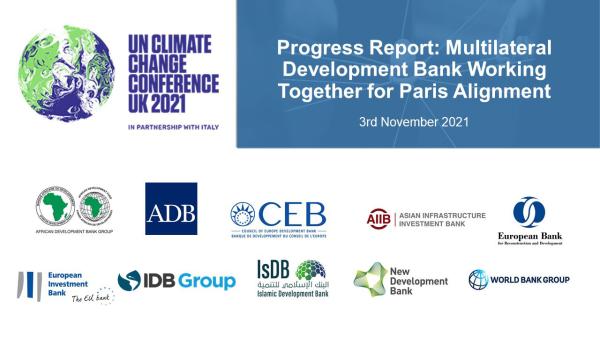
On 3 November, representatives from the Multilateral Development Banks (MDBs) gathered at COP26 in Glasgow to provide their progress update on the joint MDB Paris Alignment (PA) approach. This was the first joint MDB event at COP26 and was followed by a series of joint events on specific aspects of MDB work throughout the COP (more details on the MDB joint events programme).
Hosted by Nancy Saich, Chief Climate Change Expert at EIB, the event started with a high-level conversation on the importance of Article 2.1c of the Paris Agreement and the latest developments in this important area of aligning financial flows with Paris goals, and the role of MDBs. Danny Alexander, Vice President for Policy and Strategy at the Asian Infrastructure Investment Bank (AIIB) and Al-Hamndou Dorsouma,
Acting Director Power Energy Climate Change & Green Growth at African Development Bank, highlighted the importance of MDBs in providing climate finance and the need to scale it up (notably for adaptation), but also the importance of upstream client support, which is so important in developing countries context. The climate finance and advisory gap in sub-Saharan Africa was highlighted as particularly acute, with only two countries having developed their Long-Term Strategies (LTSs) to meet their Paris Agreement commitments.
It is to be noted that MDBs have agreed on a set of common principles for LTS support and are currently exploring the potential of developing a joint LTS Facility to help developing countries and other public sector clients prepare and implement such strategies, as also announced in the COP26 Joint MDB Statement on collective climate ambition.
In the second session, representatives from AFDB, ADB, EBRD, EIB and IFC presented an overview and updates on the six Building Blocks (BBs) of the MDBs’ PA approach, launched at COP24. Covering alignment with mitigation and adaptation goals (BB1 and BB2), accelerated contribution to the transition through climate finance (BB3), engagement and policy development support (BB4), transparent reporting (BB5) and aligning internal activities – also labelled as “walking the talk” (BB6), these building blocks serve as the basis for the joint MDB approach towards alignment with the objectives of the Paris Agreement, while fully acknowledging each MDB’s mandate, capability and operational model.
Since 2019, MDBs have road-tested Paris Alignment methodologies, with substantial progress notably in terms of methodologies for direct investment operations (see the Joint MDB Assessment Framework for Paris Alignment for Direct Investment Operation) and increasingly also for intermediated finance. They are also working on approaches for policy-based lending.
One of the main areas where MDBs can add value to their clients lies in joint support for building robust and realistic client-owned, low-carbon and climate-resilient development strategies. All in all, MDBs demonstrated they are moving from concept to practice with the joint methodologies providing guidance to the broader development community (a number of which are shared below).
Going forward, MDBs will continue to trial and improve their PA methodologies, with an increased focus on adaptation and mobilising of private finance for climate action. They will also strengthen client support by enhancing MDBs cooperation on NDCs, country and other clients’ Long Term Strategies, and Just Transition activities.
Throughout their Paris Alignment work, MDBs will also continue working with partners to transfer knowledge and to enhance comparability and consistency.
In his closing remarks, Marc Bowman, Vice-President, European Bank for Reconstruction and Development (EBRD) praised the exemplary MDB cooperation on the technical level, which resulted in a development of joint methodologies, guidance notes and piloting new approaches. Going well beyond a pure compliance exercise, Paris Alignment has been a real game-changer with multiple positive spill overs across the MDBs’ operations and among their clients.